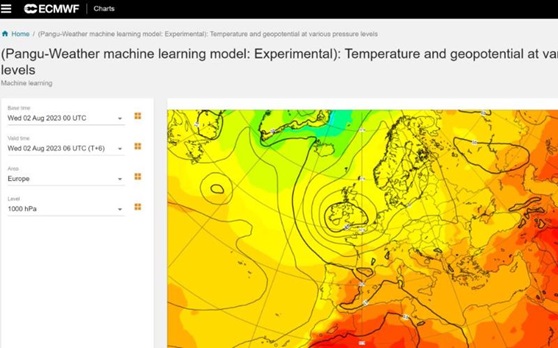
Huawei Cloud’s Pangu-Weather Model, an AI model for global weather forecasting, is now available on the website of the European Centre for Medium-Range Weather Forecasts (ECMWF) . On this website, global weather forecasters, meteorologists, weather enthusiasts, as well as the general public can now view Pangu-Weather’s 10-day global weather forecasts for free. ECMWF also released a technical report titled The rise of data-driven weather forecasting which tested Pangu-Weather. The report includes a comparison between the forecasts made by Pangu-Weather and ones from ECMWF IFS (a leading global NWP system), from April to July this year.
“The results are very promising, with comparable skill for both global metrics and extreme events, when verified against both the operational analysis and synoptic observations.”
According to the report, the uptake of machine learning methods like Pangu-Weather could be a game-changer compared to the incremental and rather slow progress of traditional numerical weather prediction (NWP) methods. Before Pangu, forecast execution had been increasing by about one day per decade (according to the World Meteorological Organization, or WMO), which can be attributed to the high computational cost of running a forecast with standard NWP systems. ML models are poised to revolutionize weather forecasting with predictions that require much lower computational costs and that are equally or more accurate.
ECMWF is now running a series of data-driven forecasts as part of its operational suite. The ECMWF website shows the forecasts made by Pangu-Weather in six different types of charts, including: mean sea level pressure and 850 hPa wind speed, 500 hPa geopotential height and 850 hPa temperature, mean sea level pressure and 200 hPa wind, temperature and geopotential at various pressure levels, 2 m temperature and 10 m wind speed, wind speed and geopotential heights at various pressure levels. All of this information is critical to predicting the development of weather systems, storm trajectories, air quality, and weather patterns. ECMWF recently used Pangu-Weather to successfully predict the path of Typhoon DOKSURI which landed in southern China in July.
ECMWF has called for more efforts from the global weather forecasting community to use AI models as additional components of their forecasting systems and to further explore the strengths and weaknesses of such models.



